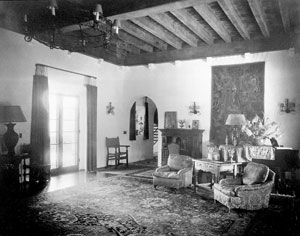Decades ago, Steve Jobs purchased the historic Jackling mansion in Silicon Valley. In February, he finally succeeded in tearing the house down.
| Photo courtesy Town of Woodside History Committee |
The white-stucco house had an unusual and superbly insulating double-wall system, evoking the heft of adobe. The massing drew inspiration from Andalusian villages. |
Culminating years of legal battle with preservationists, Apple Computer CEO Steve Jobs finally demolished the historic Jackling House on his property in Woodside, California, in February. This affluent Silicon Valley enclave, some 30 miles from San Francisco, issued the demolition permit, and, within days, the 1926 mansion—by architect George Washington Smith, father of Spanish Colonial Revival style in the U.S.—was flattened, leaving, in a cloud of dust, issues relevant far beyond the picturesque town of Woodside.

With original finishes and fittings largely intact, the interior included thousands of handmade Tunisian and Spanish ceramic tiles, dark wood beams, wide-plank white oak floors, an Aolian pipe organ, and copper-rich custom hardware and chandeliers.
The saga of Jobs and the 17,250-square-foot, 14-bedroom mansion dates back to 1984, when he purchased it with six acres for a reported $2 million. He was 29 years old and had just launched Macintosh. Early photos of Jobs at the house suggest its fine condition, though his bachelor furnishings apparently amounted to little more than a mattress and state-of-the-art audio system. Whatever his original intentions, he would later scorn the house as “an abomination.” After living there a decade and then renting it out, he left it vacant from about 2000. He later maintained, “I bought [the property] to tear down the house, [but] I've been very busy the last 20 years.” He wanted to replace it with a smaller home for his family.
Easier said than done, even on private property. Because the mansion was over 50 years old, its demolition required review under the California Environmental Quality Act (CEQA), extending protections to historical resources. The review found the house eligible for California’s Register of Historical Resources. Later the National Trust for Historic Places would weigh in, defending its worthiness for preservation.
The mansion’s original owner, copper magnate Daniel C. Jackling, a self-made millionaire, had revolutionized America’s copper industry. The white-stucco house Smith created for him had an unusual and superbly insulating double-wall system, evoking the heft of adobe. The massing drew inspiration from Andalusian villages (though another architect’s bulky additions, of 1931, detracted from Smith’s composition). With original finishes and fittings largely intact, the interior included thousands of handmade Tunisian and Spanish ceramic tiles, dark wood beams, wide-plank white oak floors, an Aolian pipe organ, and copper-rich custom hardware and chandeliers.
Despite the house’s historic value, Woodside issued a demolition permit in 2004, citing “overriding considerations.” An ad hoc citizens’ group sued the town for violating CEQA. In January 2006, California Superior Court ruled Jobs could not destroy the building, holding that local government had bent its statutes in the service of one powerful individual. Jobs appealed the decision and lost.
But the very the laws created to protect historic resources would ultimately provide the loophole for Jobs to satisfy his quest. For long periods, the house was left to decay, open to the elements, with doors and windows removed, no plywood covers, and holes drilled through the walls.
If the law prohibits owners from destroying or adversely altering cultural resources unless they can demonstrate the absence feasible alternatives, why not coax natural forces into quietly delivering a coup de grâce? This insidious practice, more common among developers bent on replacing a historic property with a commercially lucrative one, is known as willful demolition by neglect. Though some large municipalities have ordinances against it, Woodside, like most small towns, has none.
By 2008, Jobs reworked his proposal and reapplied for the permit, which the town granted and preservationists contested in court. His case rested on a questionable cost comparison: meticulous historic restoration of the derelict mansion with extensive luxury enhancements versus replacing the house with a 6,000-square-foot home (by Bohlin Cywinski Jackson, designers of the Apple Stores). This time, the court ruled in Jobs’ favor.
His concession, as early as 2004, was to give the house to anyone willing to move it. But, it seems, no interested party was taken seriously, including Woodside residents Richard Pivnicka, who had successfully restored other distressed historic properties, and Magalli and Jason Yoho, who committed to a state-of-the-art method for dismantling historic structures and a detailed restoration plan, endorsed by the National Trust. At least some of the proposals needed “a reasonable contribution” from Jobs toward the relocation. No deal progressed.
But what if Jobs had put the funds he poured into destroying the house toward its creative salvation? What if he’d embraced relocation as win-win—freeing his land while preserving a cultural resource? Would a “reasonable contribution” (public or undisclosed) have impinged on a man with $8 billion-plus net worth? Or why not sell the property years ago, and be done with it?
According to Brian Turner, a National Trust regional attorney, “In property disputes, people tend to defend their initial position. They develop tunnel vision, dig in their heels.”
The house is now history, but, in keeping with the town’s stipulations, most of its interior fittings were salvaged—including Victorian marble sinks, reputedly from a house Jackling demolished in the 1920s to build his estate.







Post a comment to this article
Report Abusive Comment